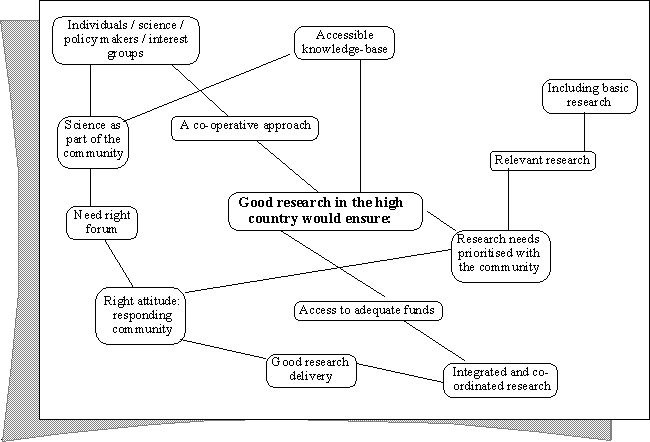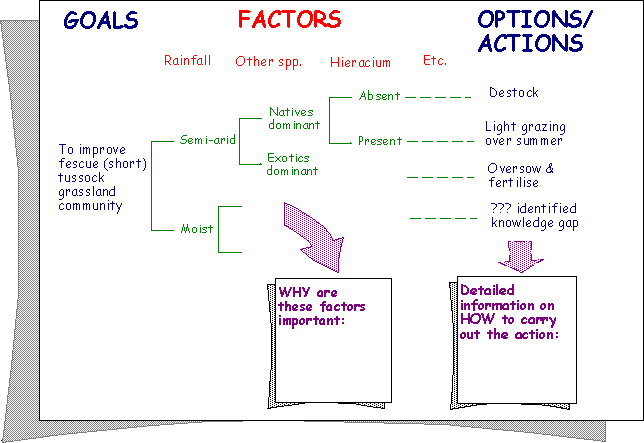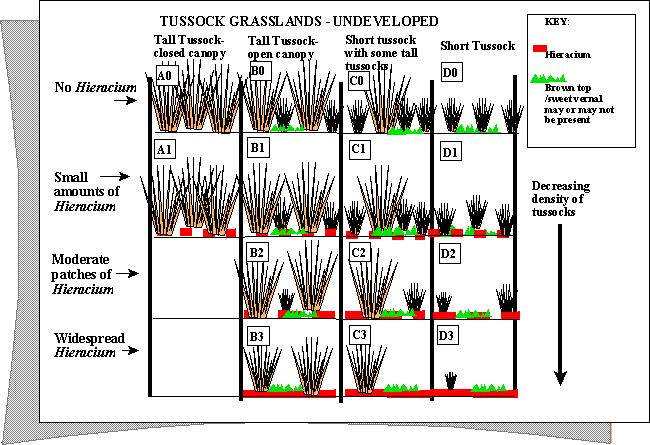CHAPTER 5
CHAPTER 5
Sharing experiences and developing 'useful knowledge'
[Chapter 5 in: Allen, W.J. webmanager (at) learningforsustainability.net (2001) Working together for environmental management: the role of information sharing and collaborative learning. PhD (Development Studies), Massey University.]
Time period in which main work on this issue carried out:
| |||||||||||
| Jul- 94 | Jan- 95 | Jul- 95 | Jan- 96 | Jul- 96 | Jan- 97 | Jul- 97 | Jan- 98 | Jul- 98 | Jan- 99 | Jul- 99 | Jan- 00 |
Allen, W.J. & Bosch, O.J.H. (1996) Shared experiences: the basis for a cooperative approach to identifying and implementing more sustainable land management practices. Pp. 1-10 in Proceedings of Symposium "Resource management: Issues, visions, practice' Lincoln University, New Zealand, 5-8 July 1996
The background to the second version of ISKM, and a re-evaluation of the need for such an adaptive programme approach, are discussed in this chapter. This highlights the importance of seeing the outcome of research as to develop 'useful knowledge' rather than a decision support system. This change in focus is also set against a growing split over the past 200 years between science and management. The need for improved forums for communication is shown, along with examples. Finally, some lessons are provided from experience with workshops involving scientists and farmers to show the need to develop a common language although, as pointed out, this will sometimes require less commonly used communication approaches such as pictures.
To conceive of knowledge as a collection of information seems to rob the concept of all its life ... Knowledge resides in the user and not in the collection. It is how the user reacts to a collection of information that matters.(Churchman 1971 p.10).
During the second year of the HMP the initial ISKM framework, outlined in the previous chapter, was significantly revised. One contributing factor was the observation that although the programme had always been talked about and presented as a collaborative effort, which would use facilitated workshops as a mechanism to involve interested farmers and scientists in developing the final version of management guidelines and underpinning ecological understanding -- most people were waiting for the HMP science staff to complete the work and come up with some 'answers', or alternatively appeared relatively disinterested in the work. The initial presentation of the approach obviously put too much emphasis on the development of a DSS, which appeared to be subsequently interpreted by farmers that the programme's main aim was 'science' rather than 'farmer' focussed. What eventually prompted a rethink by the science staff was the complete absence of farmers at a well-advertised local meeting one afternoon.
In response we convened a meeting of Central Otago farmers to renegotiate the issue of whether or not a collaborative research approach was desired, and if so, to determine the next steps that needed to be taken by both farmers and researchers. Rather than presenting our approach as a given, a decision was made to use a more open facilitated technique to ask farmers how they wished to see science carried out. This, in turn, was regarded as a way of evaluating the appropriateness of the ISKM approach. Accordingly, during this meeting I used a current/preferred scenario technique to help the farmer participants in outlining the current problems they had with research, and to develop those features they wished to see undertaken by research. The resulting mind maps are shown in Figures 5.1 and 5.2 below.

Figure 5.1 Current problems with research in the high country (edited mind map developed by participants at Alexandra 19/3/96).

Figure 5.2 How participants would like to see research in the high country (edited mind map developed by participants at Alexandra 19/3/96).
Prior to the meeting the HMP staff had been discussing the problems caused by the perception that the programme was more interested in developing a DSS than solving problems. However, when Tony Jopp (HMP Steering Committee chairman) listened to the discussion of what we hoped the programme would do he pointed out that what ISKM was really about was developing 'useful knowledge'. Given this 'reframing' of the ISKM framework, participants were then asked to re-evaluate the desired factors they had outlined in their preferred scenario (Figure 5.2). During the subsequent discussion it was agreed that this framework has the potential to meet most of the desired outcomes. This provided some buy-in from farmers to the research process, and confirmation that the HMP was on the right track.
A final workshop session focussed on identifying relevant areas of research in addition to Hieracium that could be tackled with this framework. These were then prioritised and the meeting concluded with a number of farmer volunteers agreeing to take the next phase of this participatory research back into the community to look at the following issues: grazing management, burning, conservation and water quality. It was envisaged that these farmer volunteers could co-ordinate farmer input to build on the information that had already been collected from the rural community through the semi-structured interviews conducted under the HMP.
Collectively then, this meeting and the preparations for it led to the second version of ISKM shown in this chapter paper (see Figure 5.7). Modifications include: i) an initial scoping phase; and ii) 'useful knowledge' as the main outcome, with the DSS as a by-product of this.
During this year (1995/96) my main role in the HMP was as a facilitator of the different workshops that were held. In addition to the one already mentioned, a further three workshops -- or community dialogue processes -- were subsequently held in different parts of the high country 'to work through the synthesised material on Hieracium and develop some consensus on a final structured format for presenting the knowledge-base' (HMP newsletter April 1996 p.1). Also during this period I was involved in converting the original computer-based HMP decision support module from a stand-alone package developed with object-orientated software to an Internet-based version. This included adding the information gained during the workshops.
Workshop format and lessons
During the HMP workshops a decision tree approach was used to unlock and structure existing knowledge. This is detailed in Bosch et al. (1999). The decision tree approach is illustrated in Figure 5.3, as it would be developed on a whiteboard during a workshop session. The session begins with defining the management goals and targets for the issue under consideration. These are written on the left-hand side, and participants are asked how they would achieve these goals (from their own experience and knowledge). The various options and best management practices are listed on the right-hand side as they are supplied by participants. These steps are not only needed at the beginning, but they are also relatively easy for participants to respond to. The example shown below also illustrates the holistic way in which the programme sought to deal with Hieracium. That is, farmers do not manage for Hieraciumalone, but rather address it as one problem within a wider goal -- in this case as part of the management of a tussock grassland community.
Once this is done, the facilitator returns to the top of the options/actions list, and initiates a second round of discussions among participants with a question such as, 'To achieve goal x, you could use this option or strategy under all circumstances and conditions?'. This will normally unlock a reaction from participants that the effective use of the particular option or strategy will depend on a number of factors, e.g. rainfall zone. These factors that could influence decision making (i.e. cause branches in a decision tree) are then written down in the middle section of the whiteboard.

Figure 5.3 Example of a decision tree being developed during a workshop, indicating the points at which 'why' and 'how' questions could unlock information in a structured way.
The facilitator then asks why these factors are important, and how they will influence decision making. The reasoning of participants is recorded on tapes or directly entered onto a word processor for later use as additional information or help files in information packages (e.g. manuals, leaflets, computerised decision support systems). Information on how a particular factor will influence decision making is used to draw the branches of the decision tree. For example, if rainfall zone is important, the actual boundaries at which different options would apply are recorded on the decision tree. Unknowns should be recorded as question marks on the trees.
Once there is agreement on which strategy or option would apply under what circumstances, information is sought from the participants on how the strategy should be carried out. The level of detail recorded must be adequate to allow any end-user to implement the action without further help (than is available in the information system).
This process is repeated for all options or actions for each management goal initially identified. The decision trees, additional information, and question marks form the basis for further refinement with knowledge from scientists and other experts, the identification of questions and research gaps, and for easy processing into manuals or computerised information systems. Participants (end-users) see at the end of the session their hand in the design and content of the information system, which would lead to better uptake or acceptance of the information. An important principle, however, is never to summarily dismiss any piece of information given by an individual, even if most participants disagree on its applicability. (Bosch et al. 1991).
While the idea of bringing people together to develop a common understanding of issues and what might be an appropriate set of responses sounds easy enough, in practice one of the main challenges turned out to be the development of a common language. For example, it was immediately apparent that everyone had their own idea of what different states of tussock grassland were. Although not planned, this problem was largely overcome in the second of these meetings when Roger Gibson (a Landcare Research ecologist) sketched out the diagram shown in Figure 5.4. The time involved in both agreeing on (and often renegotiating) roles and goals, and developing a common language can be seen as contributing reasons why participatory approaches take time.
Another challenge is providing participants with a common understanding of the wider context within which information is presented. This is particularly evident when the results of research findings are being presented to farmers. These are usually developed during an inquiry into a small part of the wider land management enterprise. In these cases it is helpful to show how the research findings relate back to the wider system, and to highlight who is most likely to use the research findings. In some cases these may be used by the land manager, but in other cases it may be of most use for other researchers.

Figure 5.4 Pictorial representation of tussock states developed through HMP workshops.
Writing the paper, that is subsequently provided in this chapter, provided an opportunity to reflect on these issues related to running multi-stakeholder community-dialogue processes. The paper also provides a broad perspective on how the links between science and management have become increasingly strained over the past two centuries. The implications are then looked at in terms of the different questions being asked of science in recent years as the emphasis of questions being asked has changed from production to sustainability. Equally importantly, the lessons gained through running these early workshops provided a base by which to improve the effectiveness of subsequent forums.
See also the following paper which represents the remainder of this chapter: Allen, W.J. & Bosch, O.J.H. (1996)Shared experiences: the basis for a cooperative approach to identifying and implementing more sustainable land management practices. Pp. 1-10 in Proceedings of Symposium "Resource management: Issues, visions, practice' Lincoln University, New Zealand, 5-8 July 1996
| <<< BACK | CONTENTS | NEXT >>> |
| Back to Learning for Sustainability research index This site is compiled and maintained by Will Allen (PhD) (webmanager (at) learningforsustainability.net ). |


Komentar
Posting Komentar